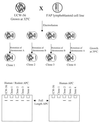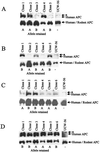Analysis of masked mutations in familial adenomatous polyposis
- PMID: 10051640
- PMCID: PMC26782
- DOI: 10.1073/pnas.96.5.2322
Analysis of masked mutations in familial adenomatous polyposis
Abstract
Familial adenomatous polyposis (FAP) is an autosomal-dominant disease characterized by the development of hundreds of adenomatous polyps of the colorectum. Approximately 80% of FAP patients can be shown to have truncating mutations of the APC gene. To determine the cause of FAP in the other 20% of patients, MAMA (monoallelic mutation analysis) was used to independently examine the status of each of the two APC alleles. Seven of nine patients analyzed were found to have significantly reduced expression from one of their two alleles whereas two patients were found to have full-length expression from both alleles. We conclude that more than 95% of patients with FAP have inactivating mutations in APC and that a combination of MAMA and standard genetic tests will identify APC abnormalities in the vast majority of such patients. That no APC expression from the mutant allele is found in some FAP patients argues strongly against the requirement for dominant negative effects of APC mutations. The results also suggest that there may be at least one additional gene, besides APC, that can give rise to FAP.
Figures



Similar articles
-
Contribution of APC and MUTYH mutations to familial adenomatous polyposis susceptibility in Hungary.Fam Cancer. 2016 Jan;15(1):85-97. doi: 10.1007/s10689-015-9845-5. Fam Cancer. 2016. PMID: 26446593 Free PMC article.
-
APC haploinsufficiency, but not CTNNB1 or CDH1 gene mutations, accounts for a fraction of familial adenomatous polyposis patients without APC truncating mutations.Lab Invest. 2003 Dec;83(12):1859-66. doi: 10.1097/01.lab.0000106722.37873.8d. Lab Invest. 2003. PMID: 14691304
-
Novel mutations of the APC gene in familial adenomatous polyposis in Greek patients.Cancer Genet Cytogenet. 2003 Feb;141(1):65-70. doi: 10.1016/s0165-4608(02)00723-9. Cancer Genet Cytogenet. 2003. PMID: 12581900
-
Familial adenomatous polyposis: from bedside to benchside.Am J Clin Pathol. 1998 May;109(5):521-6. doi: 10.1093/ajcp/109.5.521. Am J Clin Pathol. 1998. PMID: 9576568 Review.
-
[From gene to disease; the APC gene and familial adenomatous polyposis coli].Ned Tijdschr Geneeskd. 2000 Oct 14;144(42):2007-9. Ned Tijdschr Geneeskd. 2000. PMID: 11072519 Review. Dutch.
Cited by
-
COL11A1 in FAP polyps and in sporadic colorectal tumors.BMC Cancer. 2001;1:17. doi: 10.1186/1471-2407-1-17. Epub 2001 Oct 29. BMC Cancer. 2001. PMID: 11707154 Free PMC article.
-
Preventive surgery for colon cancer in familial adenomatous polyposis and hereditary nonpolyposis colorectal cancer syndrome.Langenbecks Arch Surg. 2003 Mar;388(1):9-16. doi: 10.1007/s00423-003-0364-8. Epub 2003 Mar 27. Langenbecks Arch Surg. 2003. PMID: 12690475 Review.
-
Loss of single immunoglobulin interlukin-1 receptor-related molecule leads to enhanced colonic polyposis in Apc(min) mice.Gastroenterology. 2010 Aug;139(2):574-85. doi: 10.1053/j.gastro.2010.04.043. Epub 2010 Apr 21. Gastroenterology. 2010. PMID: 20416302 Free PMC article.
-
Mutational analysis of OGG1, MYH, MTH1 in FAP, HNPCC and sporadic colorectal cancer patients: R154H OGG1 polymorphism is associated with sporadic colorectal cancer patients.Hum Genet. 2004 Nov;115(6):498-503. doi: 10.1007/s00439-004-1186-7. Epub 2004 Sep 24. Hum Genet. 2004. PMID: 15449173
-
Familial adenomatous polyposis patients without an identified APC germline mutation have a severe phenotype.Gut. 2004 Feb;53(2):266-70. doi: 10.1136/gut.2003.019042. Gut. 2004. PMID: 14724162 Free PMC article.
References
-
- Petersen G, Codori A-M. In: The Genetic Basis of Human Cancer. Vogelstein B, Kinzler K W, editors. New York: McGraw–Hill; 1998. pp. 591–599.
-
- Giardiello F M. In: Gastrointestinal Cancers: Biology, Diagnosis, and Therapy. Rustgi A K, editor. Philadelphia: Lippincott–Raven; 1995. pp. 367–377.
-
- Powell S M, Petersen G M, Krush A J, Booker S, Jen J, Giardiello F M, Hamilton S R, Vogelstein B, Kinzler K W. N Engl J Med. 1993;329:1982–1987. - PubMed
-
- Nagase H, Su Y. Hum Mutat. 1993;2:425–434. - PubMed
Publication types
MeSH terms
Substances
Grants and funding
LinkOut - more resources
Full Text Sources
Miscellaneous

